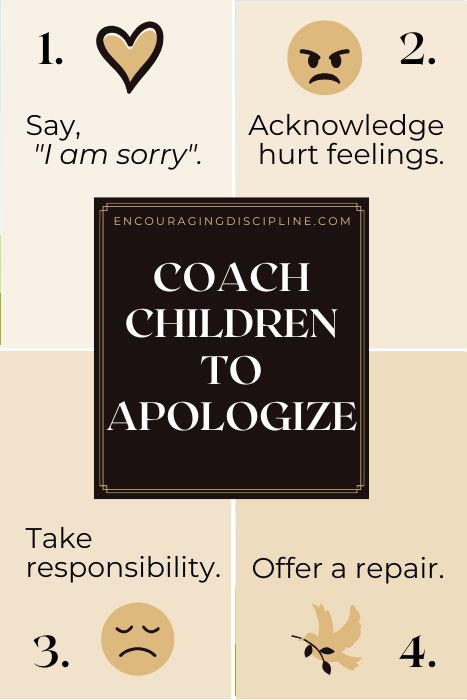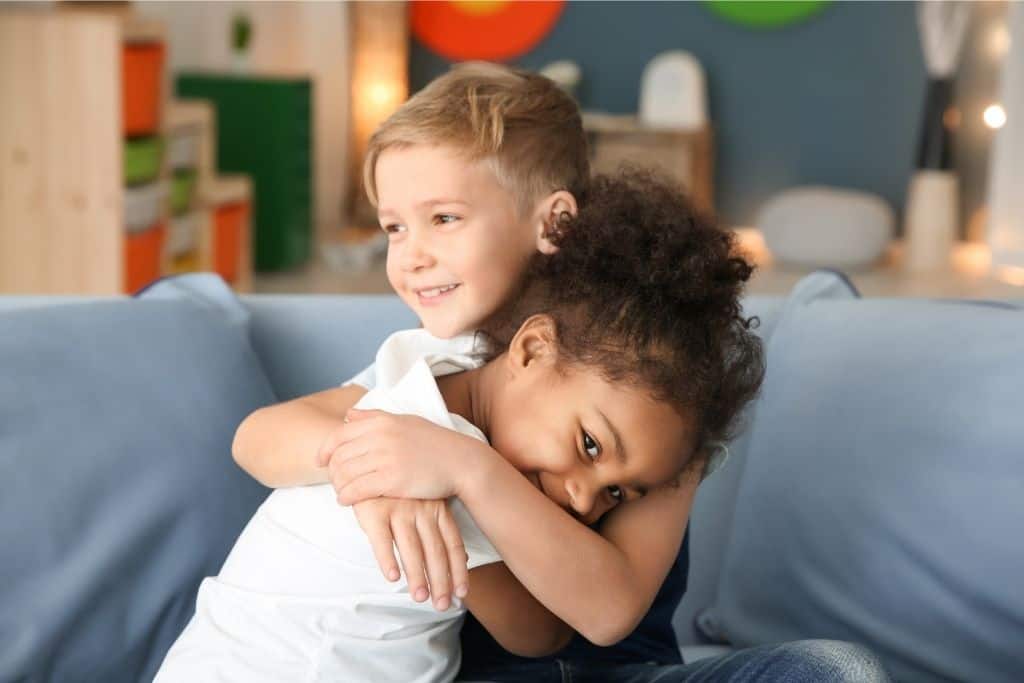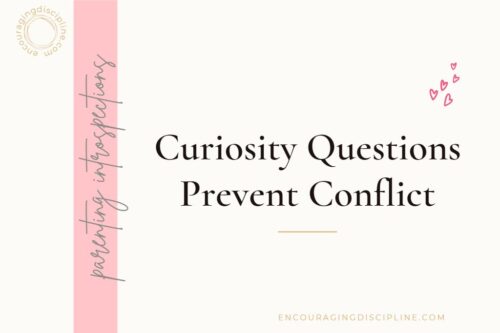Teaching Kids How to Apologize With Empathy
Getting your child to apologize with empathy takes a bit of work, but this is a skill that they can learn. In this practical guide, I will walk you through the steps to teach your child to apologize sincerely. Your child will learn the words to use for an authentic apology and you will be able to coach your child when things do not go as expected.
You’ve probably heard that you should not force your children to apologize. So what should you do instead? This doesn’t mean we should be permissive and not address situations in which our child hurts someone else’s feelings, property, or body. But how we do it matters and can make a big difference in what lessons and beliefs our children draw. Here are the things you can do to get children to apologize authentically.
Table of Contents
Apologies are important
We all want our kids to have good relationships in life – with their siblings, parents, teachers, friends, partners, neighbors, and colleagues. Good relationships play an essential role in the level of overall happiness that we feel.
But maintaining good relationships requires certain skills and awareness. Therefore it is up to us to teach our children the skills that are needed to maintain good relationships that bring meaning to our lives. One skill that plays a role in maintaining relationships is apologizing. According to research, the apology plays an important role in rebuilding trust, eliciting empathy, and reducing the chance of retaliation.
When we teach our children to apologize, we support healthy relationships, teach our children to have empathy, help them understand the consequences of their actions, and help them learn how to repair any wrongdoing.
I have to add here a big caveat: We have to teach our children that the point of apologizing is not to be forgiven.
Oftentimes children will apologize because they’ve hurt someone and they feel guilty. Guilt is an unbearable feeling and they hope that receiving the other person’s forgiveness will make the guilt go away. But sometimes the person we are apologizing to is not ready to forgive us. And we have to teach our children that that’s okay. The point of the apology is to take responsibility and try to make things better.
When we change and make better choices, we can forgive ourselves, release the guilt, and the other person may be also ready to forgive us.
Why is it hard for kids to apologize?
Children hurt others accidentally or intentionally. But whatever the reason, it never feels good to cause hurt to others. Here are three possible outcomes:
- Children don’t realize they’ve hurt someone’s feelings – we can point out that the other person is hurt by their actions – they don’t feel responsible.
- They realize they’ve inadvertently hurt the other person, but know it was not intentional – they are reluctant to take responsibility.
- They feel angry or hurt in some way and want to hurt back – they think their action is justified, and they are unwilling to feel responsible.
- And finally, they don’t want to apologize if they think that they will be judged or their vulnerability will be used against them.
Trying to squeeze out a “sincere” apology is never going to work. As long as children feel bad, they will not have any understanding and generosity to extend to others.
Mistakes we make when trying to get our kids to apologize
We often tend to prompt an apology right away from our children if they make a mistake.
“Say you’re sorry!”
“What do you say?”
We urge our child to apologize mainly driven by a quick impetus to appease the other parent. We fear that we will be judged as parents. And we fear our child will be judged.
So we jump in and “encourage” our child to deliver an apology. In the moment, we forget all about the beautiful lessons we want them to learn.
However, all this does is shame our kids, and making them feel bad will not help them to learn to do better in the future.
What a coerced apology teaches children
A forced apology has unintended effects on both ends. The child receiving the apology will not perceive it as being sincere. Therefore it is less likely to produce the healing effect that we hope for. And on the other hand, our child, who is coerced to give an apology, will feel victimized and will be more likely to feel resentful instead of empathetic.
Although our intentions are good, in the moment we forget that our approach will not teach the lesson we intend to teach. Rather, here are the conclusions that our children are likely to draw:
- Their actions and feelings do not have to align.
- Pleasing others is more important than listening to their own heart.
- They are all alone in their mistakes, they have no one on their side.
- They are misunderstood.
These are not things we want our kids to learn.
How to avoid the impulse to force an apology
We have to remember that the decision to apologize has to come from inside. Our child has to feel that they want to mend the relationship. If we force the apology, it will not ring a connection with the child’s inner moral compass.
- The first thing we need to do is stay with our own discomfort.
- Let go of the fear that our child will end up a friendless asocial beast.
- Stop worrying about what others might think of our child and parenting if we don’t fix the situation immediately.
- There is no need to fix anything right away. There is no emergency. By forcing our child to apologize right away, we are only trying to make ourselves feel better and make the discomfort go away.
- Remind ourselves that good lessons are learned with a calm brain.
Teach children WHEN to apologize
Teach children to apologize in two situations:
- when they know that they have made a mistake and feel responsible
- when they realize that their actions hurt someone, even if they did not intend to be offensive. Sometimes the outcome does not match our good intentions.
Notice that both of these present intentional and unintentional harm.
Lay the groundwork for empathic apologies
To increase the likelihood that our children will want to apologize here is what we can do on an ongoing basis:
1. Model empathic apologies
Our children have to be on the receiving end of a genuine empathic apology to know what it looks and feels like. We also know too well that children learn by watching us. They are more likely to follow and copy our behaviors rather than what we tell them.
Therefore, when we make mistakes, we can model how we take responsibility, acknowledge their hurt feelings, and offer amends.
2. View mistakes as opportunities
Everybody makes mistakes. We can’t expect children to always behave impeccably. So learning how to go back and repair a mistake is an important life skill.
Making mistakes is human. Regard your mistakes as inevitable instead of feeling guilty, and you’ll learn better.
Rudolf Dreikurs
When we punish or lecture our children for making a mistake, they will learn to view mistakes as really bad things that have to be avoided at all costs. Unfortunately, this doesn’t lead to them making fewer mistakes. But rather it teaches them to avoid the negative consequences. Therefore they will not go back to fix the mistake.
Children generally feel bad about hurting other people’s feelings, bodies, or property. If we overreact, it exacerbates their discomfort and does not put them in a place where they can have the confidence and comfort to offer a sincere apology. Apologizing is a vulnerable gesture.
Instead, we can show curiosity and empathy. We can ask about what happened in an open, curious way, and show our children we still love them even when they make mistakes.
However, we can’t stop here. If we simply showed understanding of what caused our child to hurt the other person, then we would offer no guidance and boundaries. There has to be an expectation that our child fixes their mistakes. So we continue coaching our child through coming up with an apology and repair.
3. Build emotional literacy
We can expect children to apologize and they may do it. But how do we ensure that their apology is empathetic and sincere?
When children can identify the other person’s feelings, it is easier for them to get in the other person’s shoes and show empathy.
Teach children to recognize emotions, name them, and ways to deal with them. Children need to identify the feelings that lead to unwanted reactions. And it is equally essential to recognize what others are feeling. This takes a lot of practice.
Related: Books That Teach Children About Feelings
4. Teach calm-down tools
Once the child has identified a strong emotion that is likely to lead to reactions that will escalate a situation, he can learn to let off some steam by using calm-down tools.
An apology only becomes available after big feelings are released. Big feelings (such as anger, frustration, embarrassment, shame, sadness, etc.) cloud children’s ability to think clearly and to feel empathy for another person.
As such, calm-down tools are a first step in being able to access the part of the brain that is needed for repair.
Related: Teach Kids Effective Calm-Down Tools
5. Start early
It is much easier to teach young children to apologize empathically. Older children may feel more awkward and embarrassed. This is a skill that children need to become familiar with early on. It also takes a while to learn, so the more practice children get with it, the better.
[Disclosure: The following is an affiliate link, which means I earn a small commission, at no extra cost to you, if you make a purchase using the link in this post. Please read my affiliate disclaimer for more information.]
A wonderful children’s book that discusses apologies and repair, from psychologist Deborah MacNamara is The Sorry Plane.
What to include in an empathic apology
Oftentimes children are reluctant to apologize because they do not know how to do it. It is up to us to teach them the language and steps needed to apologize with empathy. If they understand and master the components of an empathic apology, and know how to deliver it with sincerity, then they will feel more confident and willing to offer it.
The questions behind an empathic apology
Follow these questions while you coach your child to apologize and teach them to use these questions on their own. These questions are the foundation that builds a strong, authentic, and empathic apology.
- WHAT: What is the other person feeling?
- WHY: Why are they feeling this way? What did I do that may have caused them to feel this way?
- HOW: How can I repair it? Could I have done something differently?
The four parts of an empathic apology
An empathic apology doesn’t stop at “Sorry”. It has four components:
- expressing regret
- validating the other person’s feelings
- admitting responsibility
- and focusing on solutions.
Here is an example:
- I’m sorry – The words that express our regret. This is the beginning of any good apology.
- You are mad/upset/sad/etc. – Acknowledge how the other person is feeling.
- Because I scribbled on your drawing. – Take responsibility for our actions that caused the other person to feel this way. This can also be stated the other way around: I scribbled on your drawing and it made you mad.
- Offer a do-over or repair. Teach children that only words are not enough. They should offer to help repair their mistake. We can offer an idea or we can ask the other person how we can make it up to them. What can I do to repair my mistake? What can I do to make it up to you? How can I fix this? A repair can also be a promise to do things differently in the future. I promise I will take better care of your toys in the future.
It’s important to teach our kids that, when they offer a repair, the other person may not be ready to forgive and move on. Many kids get stuck and want to be forgiven right away. They think that apologizing should grant them instant release. In reality, apologizing is about taking responsibility and making things right without expecting anything in return.
Now that your child knows how to apologize with empathy, your work isn’t done. Every time they make a mistake, you will have to spend some time talking them through what happened and helping them reach the point of wanting to apologize.

What NOT to include in an apology
Knowing what does not belong in an empathic apology is just as important as what goes in it. It’s important for children to learn that doing the following things will invalidate the other person’s feelings and render the apology ineffective.
- Defending their actions – becoming defensive and finding excuses for their behavior will make the apology sound false.
- Overstating the guilt and responsibility – the apology should be about the other person, not about our child. Focusing on ourselves is the opposite of apologizing with empathy.
- Blaming – the other person, someone else, or the circumstances
- Overexplaining – Even if our child knows they are right, they should abstain from trying to make the other person understand their point of view. The other person is hurt and can’t have emotional generosity. To move forward, the priority must be to heal the hurt.
Coaching children to apologize
The coaching process for apologizing sincerely can be broken down into 10 steps. You will have to go through these steps repeatedly until your child is ready to apologize with empathy on their own.
I know at first glance it may seem like a lot of steps to go through. But keep reading. Each step is a sentence that you will say, so together they give you the entire conversation that will bring your child to the point where they can apologize with empathy on their own.
The main thing to remember during this process is to stay open-minded, non-judgemental, and factual.
- State what happened: You scribbled on your brother’s drawing, then he yelled and cried. If you didn’t see what happened, you can just say, It looked as if you and your brother were arguing earlier.
- Be curious: What happened? Leave an open door for discussion. Your child is more likely to tell you what caused the incident if they don’t feel accused or like a bad person.
- Show interest to understand the offending child’s perspective: Why do you think you did that?
- Validate feelings: You felt mad that he wasn’t giving you the blue crayon. Restate what your child is telling you and show empathy for them.
- Retell what happened: So you didn’t know what else to do and you scribbled on his paper.
- Elicit empathy: Ask, How do you think he felt after you scribbled on his paper? Wait for an answer. If they don’t say anything, invite your child to take the other one’s perspective: How do you think you would feel if your brother did that to your paper? If they are having difficulty, you can simply state what you saw: Your brother was crying, or He was showing his teeth and started screaming. Then you can continue: I think he looked pretty sad/mad. Now your brother is upset. How do you feel about that? Wait for the child to respond. Here there are a few options:
✔ Your child thinks the other child deserved it – stop there and revisit the subject later. They are not ready to move into empathy just yet.
✔ If they seem remorseful, continue coaching. - Encourage a repair: Is there anything you would like to do to repair your mistake/relationship? If your child has no ideas, it is okay to suggest some that you think might be helpful. Allow your child to choose one thing that they are comfortable doing to repair their mistake.
- Practice what to say: help your child to practice what they will say to their friend or sibling to apologize. For younger children it may be difficult to use words, so you can ask how they want to show their friend or sibling that they are sorry and willing to repair.
- Acknowledge the apology: After your child apologizes and repairs, acknowledge it. You promised your brother you would not scribble on this paper again and he smiled. He felt a lot better.
- Point out how your child feels: Help your child to notice that apologizing sincerely makes them feel better too. How do you feel after you apologized to your brother and offered to repair your mistake?
Finally, practice
Although we may not see results right away, teaching our children to apologize is a skill worth investing our time and energy in. One thing to keep in mind is that our children will not do it well from the beginning and they will probably deliver many cringe-worthy apologies before they master this skill. We just need to be there for them and to keep coaching them, trusting that one day they will have the confidence to offer authentic, empathic apologies.
For children to feel comfortable and confident when they offer an apology, it helps to practice. Young children can practice with a stuffed animal, but all children benefit from doing a run-through with a parent.
Troubleshooting Guide
Here are some questions that parents have about teaching children to apologize.
My child gets upset if the other child is not accepting his apology.
Your child delivered a heartfelt apology, but the other child/person may not be ready to receive it if they are swamped by big feelings of anger, grief, sadness, or anxiety. Teach your child to offer an apology, and just leave it there. Do not demand an acknowledgment or confirmation of forgiveness. They did the right thing, now it’s time to give the other person time to process. They will let your child know how they feel when they are ready. Usually, they will feel better and be ready to forgive after the big feelings have left their body.
The hurt child is asking for an unreasonable repair.
If the other child is asking for an unreasonable repair (“Pay me $10 for messing up my drawing.”), teach your child to say, “I can’t or won’t do that”, and offer a different way to repair instead.
The other child keeps blaming my child even after he apologized.
If the other child is caught in a negative cycle and keeps blaming your child, teach your child to restate the apology one more time, then politely say “I’ve admitted my fault. You look like you are still very upset. Now I will give you some space to cool off and we can talk about it later if you wish.” Then step away.
Why should I show empathy for the offending child?
When children make a mistake, they usually know it was wrong and feel bad about it. Forcing them to give an apology without showing any empathy for their own discomfort will make them feel unseen and will increase their discomfort, which will turn into resentment. Empathy helps a child to feel safe and loved. In turn, they will be open to showing empathy for another child.
My child shows no remorse after hurting another child.
Sometimes children seem like they are not remorseful. This may be because the discomfort they are feeling from doing something “bad” is too great. They may feel fear or embarrassment. Because of this, they are not ready to feel empathy for the other person. They first need to receive empathy themselves and feel safe. Wait for a while and address the situation when your child seems calm. Then they are more open to taking another child’s perspective.
My child says “sorry” all the time without meaning it, just to get out of trouble.
If your child begins to throw around the word “sorry” with no meaning, remorse, or intent to repair, don’t worry. Use this as an opportunity to teach these skills in more depth. Your child is still learning. And especially when you hear a snarky, emphatic “sorry”, it means your child is still feeling uncomfortable or possibly afraid to become vulnerable. Ignore the annoying tone and ask your child if they are ready to repair their mistake. If they are not, give them some time, then revisit the incident later, when they are calm. Explain to your child that the word “sorry” carries no meaning if it is used without an intention to make things right.
Key takeaways
We want our children to be empathetic, compassionate, forgiving, and to ask for forgiveness. Knowing how to apologize with empathy for their actions plays a big role in maintaining their friendships and relationships.
An effective and empathic apology uses words, but restorative actions make a big difference. Therefore it is important to offer some kind of intention to repair the damage.
It takes a strong and kind person to take responsibility for their own actions. If children have the strength to offer a sincere apology, the other person is more likely to like them, trust them, and forgive them.
Apologizing doesn’t come easy to many of us. But the more practice children have with apologizing, the easier it gets.
When an apology comes from an authentic place, it requires our ego to take the back seat. The intention behind the apology is to help heal the hurt that the other person is feeling and to continue the relationship. When we apologize sincerely, the relationship is more important than our ego.
We find it easier to apologize with empathy and sincerity when we feel that we are good despite our mistakes.
Let me know in the comments below how you are dealing with apologies in your family.







